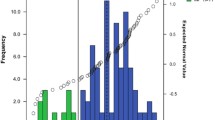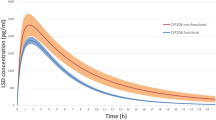Abstract
Objective
Dextromethorphan (DEM) shares part of the adverse event profile of opioids and is widely used as a probe drug for CYP2D6 phenotyping and for the assessment of CYP2D6 activity. It has also been used to assess CYP3A4 activity. This study examined the influence of anthropometric variables, oral contraceptives, smoking habits, μ-opioid receptor and MDR1 genetic polymorphisms and components of the DEM ratios on the variability of CYP2D6 and CYP3A4 metabolic ratios and on the occurrence of adverse events following DEM administration.
Methods
This was a retrospective analysis of a database in 419 healthy subjects. CYP2D6 and CYP3A4 metabolic ratios were measured as the log of the ratios of the amount of DEM to the amount of dextrorphan (DOR) and of the amount of DEM to the amount of 3-methoxy-morphinan (MET) excreted in urine during a 12-h time period, respectively, following the oral administration of 80 mg of dextromethorphan hydrobromide. Logistic regression was performed to examine the factors associated with changes in metabolic ratios and with the occurrence of adverse events.
Results
The CYP2D6 metabolic ratio allowed identification of extensive and poor metabolizers of DEM. The CYP2D6 and CYP3A4 metabolic ratios were not strictly independent one from each other. Based on multivariate analysis, the CYP2D6 metabolic ratio was a stronger independent predictor of adverse events (p<0.0001) than the CYP2D6 phenotype (p=0.05). Anthropometric variables, oral contraceptives, smoking habits, μ-opioid receptor and MDR1 genetic polymorphisms did not significantly contribute to changes in metabolic ratios or to the occurrence of adverse events.
Conclusions
Dextromethorphan can be used for CYP2D6 phenotyping, but the CYP2D6 and CYP3A4 metabolic ratios are not strictly independent one from each other. The CYP2D6 metabolic ratio predicts adverse events to DEM as does CYP2D6 phenotype, and extensive metabolizer subjects are not protected against adverse events.



Similar content being viewed by others
References
Streetman DS, Bertino JS Jr,Nafziger AN (2000) Phenotyping of drug-metabolizing enzymes in adults: a review of in-vivo cytochrome P450 phenotyping probes. Pharmacogenetics 10:187–216
Kivisto KT, Kroemer HK (1997) Use of probe drugs as predictors of drug metabolism in humans. J Clin Pharmacol 37:40S–48S
Schmid B, Bircher J, Preisig R, Kupfer A (1985) Polymorphic dextromethorphan metabolism: co-segregation of oxidative O-demethylation with debrisoquin hydroxylation. Clin Pharmacol Ther 38:618–624
Kupfer A, Schmid B, Pfaff G (1986) Pharmacogenetics of dextromethorphan O-demethylation in man. Xenobiotica 16:421–433
Tateishi T, Chida M, Ariyoshi N, Mizorogi Y, Kamataki T, Kobayashi S (1999) Analysis of the CYP2D6 gene in relation to dextromethorphan O-demethylation capacity in a Japanese population. Clin Pharmacol Ther 65:570–575
Tennezé L, Verstuyft C, Becquemont L, Poirier JM, Wilkinson GR, Funck-Brentano C (1999) Assessment of CYP2D6 and CYP2C19 activity in vivo in humans: a cocktail study with dextromethorphan and chloroguanide alone and in combination. Clin Pharmacol Ther 66:582–588
Di Marco MP, Edwards DJ, Wainer IW, Ducharme MP (2002) The effect of grapefruit juice and seville orange juice on the pharmacokinetics of dextromethorphan: the role of gut CYP3A and P-glycoprotein. Life Sci 71:1149–1160
Labbe L, Sirois C, Pilote S, Arseneault M, Robitaille NM, Turgeon J et al. (2000) Effect of gender, sex hormones, time variables and physiological urinary pH on apparent CYP2D6 activity as assessed by metabolic ratios of marker substrates. Pharmacogenetics 10:425–438
Chladek J, Zimova G, Martinkova J, Tuma I (1999) Intra-individual variability and influence of urine collection period on dextromethorphan metabolic ratios in healthy subjects. Fundam Clin Pharmacol 13:508–515
Kashuba AD, Nafziger AN, Kearns GL, Leeder JS, Shirey CS, Gotschall R et al. (1998) Quantification of intraindividual variability and the influence of menstrual cycle phase on CYP2D6 activity as measured by dextromethorphan phenotyping. Pharmacogenetics 8:403–410
Chou WH, Yan FX, Robbins-Weilert DK, Ryder TB, Liu WW, Perbost C et al. (2003) Comparison of two CYP2D6 genotyping methods and assessment of genotype-phenotype relationships. Clin Chem 49:542–551
Sachse C, Brockmoller J, Bauer S, Roots I (1997) Cytochrome P450 2D6 variants in a Caucasian population: allele frequencies and phenotypic consequences. Am J Hum Genet 60:284–295
He N, Daniel HI, Hajiloo L, Shockley D (1999) Dextromethorphan O-demethylation polymorphism in an African-American population. Eur J Clin Pharmacol 55:457–459
Lamba V, Lamba JK, Dilawari JB, Kohli KK (1998) Genetic polymorphism of CYP2D6 in North Indian subjects. Eur J Clin Pharmacol 54:787–791
Funck-Brentano C, Thomas G, Jacqz-Aigrain E, Poirier JM, Simon T, Bereziat G et al. (1992) Polymorphism of dextromethorphan metabolism: relationships between phenotype, genotype and response to the administration of encainide in humans. J Pharmacol Exp Ther 263:780–786
Kashuba AD, Nafziger AN, Kearns GL, Leeder JS, Gotschall R, Gaedigk A et al. (1999) Limitations of dextromethorphan N-demethylation as a measure of CYP3A activity. Pharmacogenetics 9:453–462
Krecic-Shepard ME, Barnas CR, Slimko J, Gorski JC, Wainer IW, Schwartz JB (1999) In vivo comparison of putative probes of CYP3A4/5 activity: erythromycin, dextromethorphan, and verapamil. Clin Pharmacol Ther 66:40–50
Min DI, Ku YM, Vichiendilokkul A, Fleckenstein LL (1999) A urine metabolic ratio of dextromethorphan and 3-methoxymorphinan as a probe for CYP3A activity and prediction of cyclosporine clearance in healthy volunteers. Pharmacotherapy 19:753–759
Jacqz-Aigrain E, Funck-Brentano C, Cresteil T (1993) CYP2D6- and CYP3A-dependent metabolism of dextromethorphan in humans. Pharmacogenetics 3:197–204
Ducharme J, Abdullah S, Wainer IW (1996) Dextromethorphan as an in vivo probe for the simultaneous determination of CYP2D6 and CYP3A activity. J Chromatogr B Biomed Appl 678:113–128
Jones DR, Gorski JC, Hamman MA, Hall SD (1996) Quantification of dextromethorphan and metabolites: a dual phenotypic marker for cytochrome P450 3A4/5 and 2D6 activity. J Chromatogr B Biomed Appl 678:105–111
Jones DR, Gorski JC, Haehner BD, O’Mara EM Jr, Hall SD (1996) Determination of cytochrome P450 3A4/5 activity in vivo with dextromethorphan N–demethylation. Clin Pharmacol Ther 60:374–384
Chou YC, Liao JF, Chang WY, Lin MF, Chen CF (1999) Binding of dimemorfan to sigma-1 receptor and its anticonvulsant and locomotor effects in mice, compared with dextromethorphan and dextrorphan. Brain Res 821:516–519
Klein M, Musacchio JM (1992) High-affinity dextromethorphan and (+-3-(-3-hydroxyphenyl)-N-(1-propyl)piperidine binding sites in rat brain. Allosteric effects of ropizine. J Pharmacol Exp Ther 260:990–999
Pechnick RN, Poland RE (2004) Comparison of the effects of dextromethorphan, dextrorphan, and levorphanol on the hypothalamo-pituitary-adrenal axis. J Pharmacol Exp Ther 309:515–522
Steinberg GK, Bell TE, Yenari MA (1996) Dose escalation safety and tolerance study of the N-methyl-D-aspartate antagonist dextromethorphan in neurosurgery patients. J Neurosurg 84:860–866
Bem JL, Peck R (1992) Dextromethorphan. An overview of safety issues. Drug Saf 7:190–199
Skarke C, Jarrar M, Erb K, Schmidt H, Geisslinger G, Lotsch J (2003) Respiratory and miotic effects of morphine in healthy volunteers when P–glycoprotein is blocked by quinidine. Clin Pharmacol Ther 74:303–311
Kharasch ED, Hoffer C, Whittington D, Sheffels P (2003) Role of P-glycoprotein in the intestinal absorption and clinical effects of morphine. Clin Pharmacol Ther 74:543–554
Siddiqui A, Kerb R, Weale ME, Brinkmann U, Smith A, Goldstein DB et al. (2003) Association of multidrug resistance in epilepsy with a polymorphism in the drug-transporter gene ABCB1. N Engl J Med 348:1442–1448
Mayer P, Hollt V (2001) Allelic and somatic variations in the endogenous opioid system of humans. Pharmacol Ther 91:167–177
Bond C, LaForge KS, Tian M, Melia D, Zhang S, Borg L et al. (1998) Single-nucleotide polymorphism in the human mu opioid receptor gene alters beta-endorphin binding and activity: possible implications for opiate addiction. Proc Natl Acad Sci U S A 95:9608–9613
East T, Dye D (1985) Determination of dextromethorphan and metabolites in human plasma and urine by high-performance liquid chromatography with fluorescence detection. J Chromatogr 338:99–112
Verstuyft C, Morin S, Yang J, Loriot MA, Barbu V, Kerb R et al. (2003) Nouvelle méthode rapide et robuste de génotypage du CYP2C9 et MDR1. Ann Biol Clin (Paris) 61:305–309
Motulsky HJ, Ransnas LA (1987) Fitting curves to data using nonlinear regression: a practical and nonmathematical review. Faseb J 1:365–374
Akaike H (1976) An information criterion (AIC). Math Sci 14:5–7
Larrey D, Amouyal G, Tinel M, Letteron P, Berson A, Labbe G et al. (1987) Polymorphism of dextromethorphan oxidation in a French population. Br J Clin Pharmacol 24:676–679
Steiner E, Iselius L, Alvan G, Lindsten J, Sjoqvist F (1985) A family study of genetic and environmental factors determining polymorphic hydroxylation of debrisoquin. Clin Pharmacol Ther 38:394–401
Bock KW, Schrenk D, Forster A, Griese EU, Morike K, Brockmeier D et al. (1994) The influence of environmental and genetic factors on CYP2D6, CYP1A2 and UDP-glucuronosyltransferases in man using sparteine, caffeine, and paracetamol as probes. Pharmacogenetics 4:209–218
Streetman DS, Ellis RE, Nafziger AN, Leeder JS, Gaedigk A, Gotschall R et al. (1999) Dose dependency of dextromethorphan for cytochrome P450 2D6 (CYP2D6) phenotyping. Clin Pharmacol Ther 66:535–541
Kallio J, Lindberg R, Huupponen R, Iisalo E (1988) Debrisoquine oxidation in a Finnish population: the effect of oral contraceptives on the metabolic ratio. Br J Clin Pharmacol 26:791–795
Siegmund W, Hanke W, Zschiesche M, Franke G, Biebler KE, Wilke A (1990) N-acetylation and debrisoquine type oxidation polymorphism in Caucasians – with reference to age and sex. Int J Clin Pharmacol Ther Toxicol 28:504–509
Hägg S, Spigset O, Dahlqvist R (2001) Influence of gender and oral contraceptives on CYP2D6 and CYP2C19 activity in healthy volunteers. Br J Clin Pharmacol 51:169–173
McCune JS, Lindley C, Decker JL, Williamson KM, Meadowcroft AM, Graff D et al. (2001) Lack of gender differences and large intrasubject variability in cytochrome P450 activity measured by phenotyping with dextromethorphan. J Clin Pharmacol 41:723–731
Vincent-Viry M, Fournier B, Galteau MM (2000) Short communication. The effects of drinking and smoking on the CYP2D6 metabolic capacity. Drug Metab Dispos 28:617–619
Eap CB, Buclin T, Hustert E, Bleiber G, Golay KP, Aubert AC et al. (2004) Pharmacokinetics of midazolam in CYP3A4- and CYP3A5-genotyped subjects. Eur J Clin Pharmacol 60:231–236
Charbit B, Becquemont L, Lepere B, Peytavin G, Funck-Brentano C (2002) Pharmacokinetic and pharmacodynamic interaction between grapefruit juice and halofantrine. Clin Pharmacol Ther 72:514–523
McCune JS, Hawke RL, LeCluyse EL, Gillenwater HH, Hamilton G, Ritchie J et al. (2000) In vivo and in vitro induction of human cytochrome P4503A4 by dexamethasone. Clin Pharmacol Ther 68:356–366
Vetticaden SJ, Cabana BE, Prasad VK, Purich ED, Jonkman JH, de Zeeuw R et al. (1989) Phenotypic differences in dextromethorphan metabolism. Pharm Res 6:13–19
Miners JO, Birkett DJ (1993) The misuse of urinary metabolite excretion data in drug metabolism studies. Pharmacogenetics 3:58–59
Weinbroum AA, Rudick V, Paret G, Ben-Abraham R (2000) The role of dextromethorphan in pain control. Can J Anaesth 47:585–596
Price LH, Lebel J (2000) Dextromethorphan-induced psychosis. Am J Psychiatry 157:304
Marzolini C, Paus E, Buclin T, Kim RB (2004) Polymorphisms in human MDR1 (P-glycoprotein): recent advances and clinical relevance. Clin Pharmacol Ther 75:13–33
van Tellingen O (2001) The importance of drug-transporting P-glycoproteins in toxicology. Toxicol Lett 120:31–41
Sadeque AJ, Wandel C, He H, Shah S, Wood AJ (2000) Increased drug delivery to the brain by P-glycoprotein inhibition. Clin Pharmacol Ther 68:231–237
Acknowledgements
We are indebted to Martine Lebot BSc. for assaying the dextromethorphan urine samples, to Liliane Dubert for preparing and processing the DNA samples, to Jean-Louis Démolis M.D. for his participation to the inclusion of the volunteers and to the staff of the Clinical Investigation Center for their enthusiastic and careful collection of the data.
Author information
Authors and Affiliations
Corresponding author
Additional information
This study was supported by a grant-in-aid from the Institut National de la Santé et de la Recherche Médicale and the Assistance Publique-Hôpitaux de Paris at the Clinical Investigation Center of Saint-Antoine University Hospital. The legal sponsor was the INSERM.
Rights and permissions
About this article
Cite this article
Funck-Brentano, C., Boëlle, PY., Verstuyft, C. et al. Measurement of CYP2D6 and CYP3A4 activity in vivo with dextromethorphan: sources of variability and predictors of adverse effects in 419 healthy subjects. Eur J Clin Pharmacol 61, 821–829 (2005). https://doi.org/10.1007/s00228-005-0051-5
Received:
Accepted:
Published:
Issue Date:
DOI: https://doi.org/10.1007/s00228-005-0051-5




